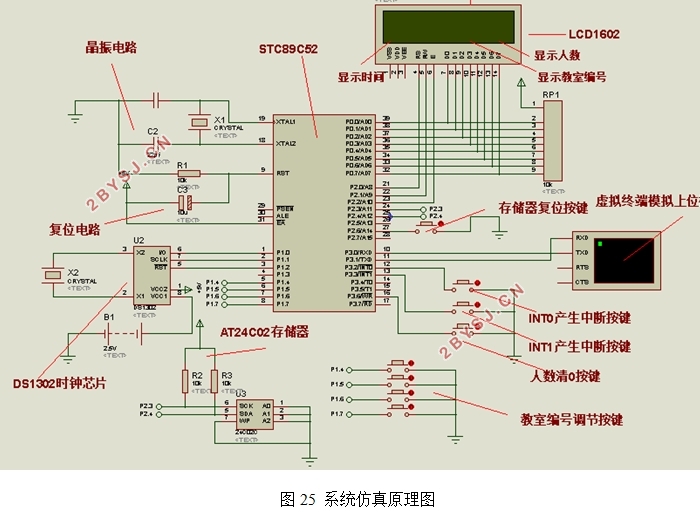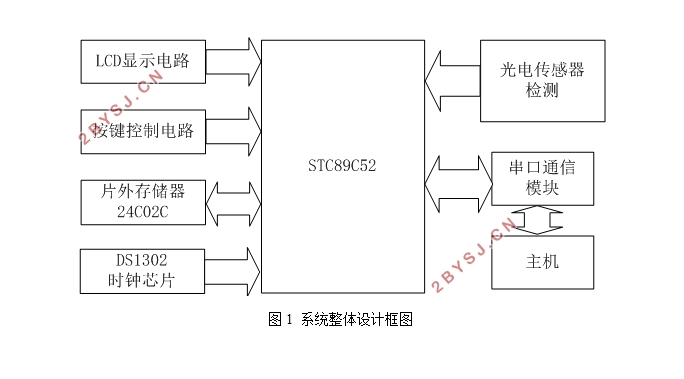教室人数监测系统设计
无需注册登录,支付后按照提示操作即可获取该资料.
教室人数监测系统设计(论文17500字)
摘要:本文给出了一个基于单片机的教室人数检测系统详细的软硬件设计。本系统分为下位机设计和上位机设计两部分。其中下位机系统以光电开关作为检测元件,STC89C52单片机作为处理器,单片机通过光电开关对人员进出进行检测,显示屏LCD1602显示进出人数,再通过按键实现对教室编号的设置,最后通过串口通信将数据传送给上位机。而上位机系统通过可视化界面显示下位机发送的数据并可将数据导入EXCEL中方便用户管理,此外还可以设置更新人数阈值,对下位机人数信息清零。此系统结构简单、运行稳定、成本低,在高校里适用范围比较广。
关键词:教室人数;光电开关;单片机;串口通信;上位机
A Design of Classroom People Counting System
Abstract: The software and hardware design based on single chip is presented in detail. The system is composed of the upper monitor and lower computer. The photoelectric senor is utilized as detecting element and STC89C52 microcomputer is adopted as control core in the lower computer. The number of students in the classroom is displayed by LCD1602. The classroom name can be set by push-buttons. Data is sent to the host through the serial port of SCM. The visual interface is built on the upper monitor by qt creator, which can receive data and import them into EXCEL. It is convenient for management. In addition, the updated threshold can be set and the number of people can be cleared in the upper monitor. The system has the advantages of simple structure, stable operation and low cost, and it is suitable for using in colleges and universities.
Key words:the number of students in the classroom; photoelectric senor; single chip microcomputer; serial communication; upper monitor


目 录
1 引言 1
1.1 研究背景与研究意义 1
1.2 人数检测方法的国内外研究概况 1
1.2.1 基于人头颜色特征的人数统计 1
1.2.2 基于外形轮廓特征的人数统计 2
1.2.3 基于区域估计的人数统计 2
1.2.4 基于模型学习的人数统计 2
1.2.5 基于硬件传感器的人数统计 3
1.3 本文的主要工作 3
2 设计方案论证分析 3
2.1系统目标实现 3
2.2 人数检测方案比较与选择 4
3 人数检测系统硬件设计 5
3.1 系统整体设计 5
3.2 微控制器的选择 6
3.2.1 单片机的选型分析 6
3.2.2 单片机的可开发性 6
3.2.3 STC89C52简介 6
3.2.4 单片机最小系统 6
3.3 检测原理 7
3.3.1 光电开关的工作原理 7
3.3.2 基于E18-D80NK检测电路设计 8
3.3.3 传感器的放置 9
3.3.4 人数检测原理 10
3.4 DS1302实时时钟模块电路设计 11
3.5掉电保护模块电路设计 11
3.6 LCD显示电路设计 12
3.7 按键电路设计 13
3.8 串口通信模块电路设计 14
4 下位机系统软件设计 15
4.1主程序设计 15
4.2 初始化子程序 15
4.3 外部中断INT0子程序 16
4.4 外部中断INT1子程序 17
4.5 AT24C02读写子程序 17
4.6 LCD显示程序 18
4.7 按键扫描子程序 19
5 上位机软件设计 20
5.1 Qt与Qt Creator简介 20
5.2 上位机界面设计 20
5.3 上位机开发过程 21
5.4 上位机通信测试 22
6 系统仿真效果与实物调试结果 23
6.1 系统仿真效果 23
6.2 硬件和软件调试 26
6.3最终实物调试结果 26
7 系统改进 32
8 结束语 33
参考文献 33
致 谢 35
附录 36
